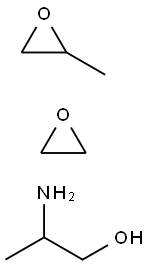TRIMETHYLOLPROPANE TRIS[POLY(PROPYLENE GLYCOL), AMINE TERMINATED] ETHER
- CAS NO.:39423-51-3
- Empirical Formula: C2H5C[CH2[OCH2CH(CH3)]nNH2]3
- Molecular Weight: 0
- MDL number: MFCD00197951
- EINECS: 500-105-6
- SAFETY DATA SHEET (SDS)
- Update Date: 2024-12-18 14:15:30
What is TRIMETHYLOLPROPANE TRIS[POLY(PROPYLENE GLYCOL), AMINE TERMINATED] ETHER?
Chemical properties
Colorless or yellowish liquid
The Uses of TRIMETHYLOLPROPANE TRIS[POLY(PROPYLENE GLYCOL), AMINE TERMINATED] ETHER
T-403 may be surface functionalized by graphene nanoplatelet (GNP) and can be used as a water coolant in closed conduit flow. It can be incorporated into poly(butylene terephthalate) (PBT) as a blend, which enhances its melt-flowability. It can also be used as a cross-linker, which facilitates the curing of ethylene-glycidyl methacrylate copolymer.
General Description
Trimethylolpropane tris[poly(propylene glycol), amine terminated] ether (T-403) is a type of polyetheramine that has a primary amine group. It can be used as an epoxy curing agent. T-403 has a hydroxyl group that reacts with the epoxy monomer to form stable ether linkages.
Flammability and Explosibility
Not classified
Properties of TRIMETHYLOLPROPANE TRIS[POLY(PROPYLENE GLYCOL), AMINE TERMINATED] ETHER
| Density | 0.981 g/mL at 25 °C (lit.) |
| vapor pressure | 0.002Pa at 20℃ |
| refractive index | n |
| Flash point: | >230 °F |
| pka | 10.25[at 20 ℃] |
| Water Solubility | 562g/L at 20℃ |
| EPA Substance Registry System | Poly[oxy(methyl-1,2-ethanediyl)], .alpha.-hydro-.omega.-(2-aminomethylethoxy)-, ether with 2-ethyl-2-(hydroxymethyl)-1,3-propanediol (3:1) (39423-51-3) |
Safety information for TRIMETHYLOLPROPANE TRIS[POLY(PROPYLENE GLYCOL), AMINE TERMINATED] ETHER
| Signal word | Danger |
| Pictogram(s) |
 Corrosion Corrosives GHS05  Exclamation Mark Irritant GHS07  Environment GHS09 |
| GHS Hazard Statements |
H318:Serious eye damage/eye irritation H411:Hazardous to the aquatic environment, long-term hazard |
| Precautionary Statement Codes |
P280:Wear protective gloves/protective clothing/eye protection/face protection. |
Computed Descriptors for TRIMETHYLOLPROPANE TRIS[POLY(PROPYLENE GLYCOL), AMINE TERMINATED] ETHER
New Products
(S)-3-Aminobutanenitrile hydrochloride 4-Methylphenylacetic acid N-Boc-D-alaninol N-BOC-D/L-ALANINOL Tert-butyl bis(2-chloroethyl)carbamate 3-Morpholino-1-(4-nitrophenyl)-5,6-dihydropyridin- 2(1H)-one Furan-2,5-Dicarboxylic Acid Tropic acid 1-Bromo-3,5-Di-Tert-Butylbenzene S-2-CHLORO PROPIONIC ACID ETHYL ISOCYANOACETATE 2-Bromo-1,3-Bis(Dimethylamino)Trimethinium Hexafluorophosphate 4-IODO BENZOIC ACID 3-NITRO-2-METHYL ANILINE 1-(2,4-DICHLOROPHENYL) ETHANAMINE (2-Hydroxyphenyl)acetonitrile 4-Bromopyrazole 2-(Cyanocyclohexyl)acetic acid 4-methoxy-3,5-dinitropyridine 1-(4-(aminomethyl)benzyl)urea hydrochloride 2-aminopropyl benzoate hydrochloride diethyl 2-(2-((tertbutoxycarbonyl)amino) ethyl)malonate tert-butyl 4- (ureidomethyl)benzylcarbamate Ethyl-2-chloro((4-methoxyphenyl)hydrazono)acetateRelated products of tetrahydrofuran








You may like
-
![Trimethylolpropane tris[poly(propylene glycol), amine terminated] ether CAS 39423-51-3](https://img.chemicalbook.in//Content/image/CP5.jpg) Trimethylolpropane tris[poly(propylene glycol), amine terminated] ether CAS 39423-51-3View Details
Trimethylolpropane tris[poly(propylene glycol), amine terminated] ether CAS 39423-51-3View Details
39423-51-3 -
 2033-24-1 98%View Details
2033-24-1 98%View Details
2033-24-1 -
 1975-50-4 98%View Details
1975-50-4 98%View Details
1975-50-4 -
 2-HYDROXY BENZYL ALCOHOL 98%View Details
2-HYDROXY BENZYL ALCOHOL 98%View Details
90-01-7 -
 2-Chloro-1,3-Bis(Dimethylamino)Trimethinium Hexafluorophosphate 221615-75-4 98%View Details
2-Chloro-1,3-Bis(Dimethylamino)Trimethinium Hexafluorophosphate 221615-75-4 98%View Details
221615-75-4 -
 61397-56-6 CIS BROMO BENZOATE 98%View Details
61397-56-6 CIS BROMO BENZOATE 98%View Details
61397-56-6 -
 14714-50-2 (2-Hydroxyphenyl)acetonitrile 98+View Details
14714-50-2 (2-Hydroxyphenyl)acetonitrile 98+View Details
14714-50-2 -
 118753-70-1 98+View Details
118753-70-1 98+View Details
118753-70-1
Statement: All products displayed on this website are only used for non medical purposes such as industrial applications or scientific research, and cannot be used for clinical diagnosis or treatment of humans or animals. They are not medicinal or edible.